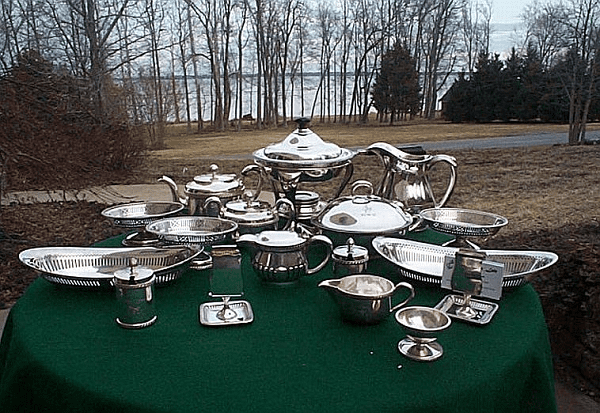Hollow ware- “Hollowware” is a term used to describe various types of metalware or other items that are hollow on the inside. Hollowware items are typically made from metal, such as silver, pewter, or stainless steel, and they are often used for serving food or beverages. These items are usually distinguished from flatware (cutlery) and are typically larger and more ornate.
Common examples of hollowware include:
- Teapots: Teapots are a classic example of hollowware. They are used for brewing and serving tea.
- Coffee pots: Similar to teapots, coffee pots are used for brewing and serving coffee.
- Sugar bowls and creamers: These are often used alongside teapots and coffee pots for serving sugar and cream with hot beverages.
- Pitchers: Pitchers come in various sizes and are used for serving a variety of beverages, including water, juice, and cocktails.
- Serving trays: Serving trays can be flat or have raised edges and are used for carrying and serving food and drinks.
- Candlesticks: Candlesticks are often decorative and are used for holding candles.
- Gravy boats: These are used to pour gravy or sauce over food at the dining table.
- Serving bowls: Serving bowls, whether for salad, fruit, or other dishes, are often considered part of hollowware.
- Chafing dishes: Chafing dishes are used for keeping food warm, often at buffets or during formal dinners.
- Punch bowls: Punch bowls are used for serving large quantities of punch at parties and gatherings.
Hollowware items are often made with intricate designs, handles, and spouts, making them not only functional but also decorative. They are commonly found in formal dining settings, fine dining establishments, and as part of special occasion table settings. These items may be made from various materials, with silver being a popular choice for antique and high-end hollowware.
What is Hollow ware
“Hollowware” refers to a category of items or utensils made of metal or other materials that are generally hollow on the inside and used for various purposes, primarily in food service and presentation. Hollowware items are typically larger and more ornate than flatware or cutlery, and they are often used for serving or displaying food, beverages, or decorative items. These items can be made from various materials, including metal (such as silver, pewter, or stainless steel), porcelain, glass, or even wood.
Common examples of hollowware include:
- Teapots and Coffee Pots: These are used for brewing and serving tea or coffee.
- Creamers and Sugar Bowls: These are used for serving cream and sugar with hot beverages.
- Pitchers: Pitchers come in various sizes and are used for serving water, juice, milk, or other beverages.
- Serving Trays: Serving trays are used for carrying and presenting food and drinks.
- Candlesticks: These are decorative holders designed for placing and displaying candles.
- Gravy Boats: Gravy boats are used to pour gravy or sauces over food at the dining table.
- Serving Bowls: Serving bowls are used for presenting salads, fruits, or various dishes.
- Chafing Dishes: Chafing dishes are used to keep food warm, often in buffet-style or formal dining settings.
- Punch Bowls: Punch bowls are used for serving large quantities of punch at parties and gatherings.
Hollowware items are often designed with aesthetic appeal, intricate details, and functional elements such as handles, spouts, or lids. They are commonly found in formal dining settings, fine dining establishments, and during special occasions or events. The choice of material for hollowware can vary based on the intended use and desired style, with precious metals like silver being a popular choice for high-end and antique hollowware items.
Who is Required Hollow ware
I apologize, but as of my last knowledge update in September 2021, there is no widely recognized or specific individual or entity known as “Hollow ware” in a personal or professional context. If this term refers to a specific person or organization, it may be a niche or relatively unknown entity, or it might have emerged or become significant after my last knowledge update.
If you can provide more context or specific details about who or what “Hollow ware” is, I would be happy to try to provide more information or assistance to the best of my ability based on the information available to me up to that point.
Where is Required Hollow ware

“Hollowware” is not a specific location or place; it is a term used to describe a category of items, typically made of metal or other materials, that are hollow on the inside and used for serving, displaying, or containing various items, such as food, beverages, or decorative objects. Hollowware includes items like teapots, coffee pots, pitchers, serving trays, and more, which are often used in dining, serving, or decorative contexts.
If you are looking for a specific location or want to find hollowware, it would depend on the context. You can typically find hollowware items in various places, including:
- Retail Stores: Many department stores, kitchen supply stores, and specialty shops sell hollowware items.
- Online Retailers: You can find a wide range of hollowware products on online marketplaces and websites specializing in kitchenware and dining items.
- Antique Shops: If you’re interested in vintage or antique hollowware, antique shops and online antique marketplaces can be a good source.
- Auction Houses: Some high-end or collectible hollowware items may be available at auction houses or online auction platforms.
- Estate Sales: Estate sales often include a variety of household items, including hollowware.
Remember, the availability of hollowware items can vary depending on your location and the specific type of hollowware you’re looking for.
How is Required Hollow ware
“Hollowware” refers to a category of items, typically made of metal or other materials, that are hollow on the inside and used for serving, displaying, or containing various items, such as food, beverages, or decorative objects. Hollowware items are designed to be both functional and decorative. Here’s how hollowware can be described:
- Design and Aesthetics: Hollowware items are often intricately designed and may feature decorative elements such as handles, spouts, and ornate patterns. They are intended to enhance the visual appeal of the table setting or presentation.
- Materials: Hollowware can be made from various materials, with metals like silver, pewter, and stainless steel being common choices. Other materials may include porcelain, glass, wood, or even plastic, depending on the purpose and style.
- Functionality: Hollowware serves a range of functions, such as serving and displaying food and beverages. For example, teapots and coffee pots are used to brew and serve hot beverages, while serving trays are used to carry and present food.
- Variety of Items: Hollowware encompasses a wide range of items, including teapots, coffee pots, creamers, sugar bowls, pitchers, serving trays, candlesticks, gravy boats, serving bowls, chafing dishes, punch bowls, and more.
- Occasions: Hollowware is commonly used in formal dining settings, fine dining establishments, and special occasions. It can add elegance and sophistication to a table setting.
- Care and Maintenance: Depending on the material, hollowware may require specific care and maintenance to preserve its appearance and functionality. For example, silver hollowware often requires polishing to maintain its shine.
Overall, hollowware is a category of items that combines both utilitarian and decorative aspects, and it plays a significant role in enhancing the dining and presentation experience in various settings.
Case Study on Hollow ware
Title: Modernizing a Hollowware Manufacturer for Sustainable Growth
Introduction: XYZ Hollowware, a well-established manufacturer of high-end silver hollowware, is facing challenges in the increasingly competitive market. They are renowned for their intricate designs and superior craftsmanship but have seen a decline in sales and profitability over the last few years. This case study aims to explore the issues XYZ Hollowware faces and suggest strategies for modernizing their operations to achieve sustainable growth.
Challenges:
- Changing Market Trends: Traditional silver hollowware is facing competition from modern materials and minimalist designs.
- Environmental Concerns: The production process for silver hollowware has come under scrutiny due to its environmental impact.
- Supply Chain Disruptions: The supply chain has been disrupted by factors like metal price fluctuations and transportation challenges.
- Aging Workforce: Many skilled artisans are nearing retirement, creating a gap in expertise.
Solutions:
- Diversify Product Range: XYZ Hollowware can introduce new lines of hollowware featuring contemporary designs and alternative materials. This approach will allow them to tap into a broader customer base.
- Sustainability Initiatives: Implement sustainable practices in the production process. Use recycled materials, reduce waste, and explore eco-friendly finishing methods. Promote these efforts to appeal to environmentally conscious customers.
- Supply Chain Optimization: Establish strong relationships with suppliers and consider long-term contracts to mitigate price fluctuations. Invest in efficient transportation and inventory management.
- Knowledge Transfer: Develop a mentorship program to transfer skills from experienced artisans to younger workers. Encourage apprenticeships and training to ensure a skilled workforce for the future.
Outcomes:
By diversifying the product range, embracing sustainability, optimizing the supply chain, and ensuring a skilled workforce, XYZ Hollowware can address the challenges they face. These strategies position them for long-term growth, appealing to both traditional and contemporary customers while contributing to sustainability efforts.
Conclusion:
XYZ Hollowware’s case exemplifies the need for established companies in traditional industries to adapt to changing market dynamics, sustainability concerns, and workforce transitions. With a well-planned approach, they can not only survive but thrive in an evolving business landscape.
This case study is purely hypothetical, but it highlights the types of challenges and solutions that a company dealing with hollowware might encounter. Real-world case studies would provide specific data and outcomes based on a company’s actual experiences and strategies.
White paper on Hollow ware
The Evolution of Hollowware in Modern Dining
Trends, Challenges, and Innovations
Table of Contents:
- Executive Summary
- A brief overview of the white paper’s main findings and recommendations.
- Introduction
- Introduce the concept of hollowware and its historical significance in dining.
- Chapter 1: Historical Significance of Hollowware
- Explore the origins of hollowware and its role in shaping dining culture.
- Highlight notable historical examples of hollowware.
- Chapter 2: Modern Dining Trends
- Examine how dining trends have evolved, impacting the use and design of hollowware.
- Discuss the influence of minimalism, sustainability, and diverse culinary experiences.
- Chapter 3: Challenges Faced by Hollowware Manufacturers
- Analyze the challenges encountered by manufacturers in the production and marketing of hollowware.
- Include issues related to materials, changing consumer preferences, and environmental concerns.
- Chapter 4: Innovations in Hollowware
- Showcase innovative designs, materials, and manufacturing techniques in contemporary hollowware.
- Highlight successful case studies in adapting to modern dining trends.
- Chapter 5: Sustainability and Eco-friendly Hollowware
- Explore how hollowware manufacturers are addressing environmental concerns.
- Discuss the use of recycled materials, sustainable production methods, and ethical sourcing.
- Chapter 6: Digital Marketing and E-commerce
- Explain how the digital age has transformed the marketing and sales of hollowware.
- Include insights on e-commerce, online branding, and social media strategies.
- Chapter 7: Consumer Engagement and Personalization
- Discuss the importance of customer engagement and the trend of personalized hollowware.
- Present case studies of companies that have excelled in customer relations and customization.
- Chapter 8: Future Prospects and Recommendations
- Offer insights into the future of hollowware in dining and hospitality.
- Provide recommendations for manufacturers, retailers, and consumers on adapting to changing trends.
- Conclusion
- Summarize key takeaways and the evolving landscape of hollowware in modern dining.
- Appendices
- Include additional resources, references, and supplementary information.
- Glossary
- Define key terms related to hollowware and dining culture.
Executive Summary:
Hollowware, the elegant and functional category of tableware, has witnessed a transformation in the modern dining landscape. This white paper explores the historical significance of hollowware, the evolving dining trends influencing its design, and the challenges faced by manufacturers in this industry. It also highlights the innovations and adaptations that are paving the way for the future of hollowware. The paper underscores the growing importance of sustainability, digital marketing, and personalized customer experiences. As dining culture continues to evolve, hollowware remains a vital element in the art of presentation, reflecting the shifting preferences and values of consumers.





